Gallery Talk: Freaks, Geeks, and Strange Girls
For logistical reasons (and, if I’m honest, to keep my nerves at bay), I decided to not capture the December 6th artist and curator talk for my solo show at Radiator Gallery on video. I was happy that curator Peter Gynd (who leads an excellent conversation, BTW) caught the audio on his phone and kindly shared it with me.
There were 30 or so attendees who enjoyed the talk immensely. I thought I would transcribe it and share here for those of you who are keen to learn more about my practice, process, and, in particular, this intensely detailed series.
Confession: Transcribing the audio was a bit of a harsh reality check ;-).
There’s nothing quite like hearing yourself consistently substituting “and, so…” for sentence breaks instead of ending a thought and then starting a new one after a clean pause. As it turns out that my comfort words are, “actually”, “sort of”, “kind of”, “like”, “um, so”, and “and”. I also have a habit of starting a sentence, then changing my mind part way through and heading in a completely different direction. Quite natural and acceptable in conversation, but a mess to read.
To make your experience of the transcript more pleasant, I’ve polished up the text, omitted many of these personal verbal idiosyncrasies, and added images for reference throughout.
Enjoy!
FYI, it was a 30 minute conversation followed by a 15 minute Q & A. Get yourself a beverage (we had wine!) and then sit down to read. It’s the next best thing to having been there. And don’t feel sad about about not being able to participate in the Q&A – feel free to ask a question in the comments!
Tamas Veszi: Hi everybody. Thanks for coming to Radiator Gallery. If you don’t know the space, just a few words – we are a curatorial platform. We’ve been here for seven years. We also have studios and the gallery, and this is our first solo show, by Jody MacDonald – congratulations. [clapping]
Thank you. Curated by the one and only Peter Gynd. We’ve wanted to work together for a long time and it finally happened with the best artist.
Freaks, Geeks, and Strange Girls is a super exciting show. It shows the dedication of Jody and her way of thinking, which I think is pretty amazing. And the curiosity about diverse things that come together: politics, the circus, the sideshow, art history, and the way you put them together I really like. You know, that was the thing that really intrigued me and Daniela. So, now you know they’re going to talk about the work. Thank you and enjoy.
Peter Gynd: First of all thank you everybody for coming.
Thank you, Tamas, and thank you to Daniela and Radiator Gallery for hosting this exhibition. We’re going to talk for probably around a half an hour. We’ll get into the specifics of this work and we’ll talk a little bit about some other things as well and then we’ll have a Q & A period at the end so if you have any questions you can remember them and pitch them at the end. If it’s something super burning pertaining to what we’re talking about at that second, you know, then feel free to chime in.
So, first of all I just want to say I had a great time working on this exhibition with Jody. It really was a pleasure and an honor to do this and especially an honor to be part of a first solo exhibition at Radiator Gallery, so thank you.
Jody MacDonald: Thank you, Peter.
PG: We’ll get into discussing the specifics of this work, but before we do that I was kind of hoping we could talk a bit about your background as an artist and some of your previous bodies of work because I think they do relate a lot to this work.
JM: They do, yes.
PG: Why don’t you talk a little bit about that.
JM: One of the most important things – foundational things – that you all should know about me is that I attended a vocation high school that had a great intensive art program. And in that program I majored in textiles and printmaking. So textiles, multiples – this idea of working with multiples – just has carried through my 30 plus years of practice.
Didn’t matter what vehicle I was using – I started out as a traditional object maker, sculptures and paintings. I moved into installation work. From there I moved into some kinetic, interactive work. From there I moved into performance. In performance I actually missed making objects, so I’ve come back around to being an object maker that actually combines all of those aspects in my practice now.
PG: Do you want to maybe touch briefly on the specifics of your two previous bodies of work?
JM: There’s Will the Real Slim Shady Please Stand Up? That body of work came from…well, maybe I should talk about where the dolls came from…or how that started, because that came from missing doing object-based work. I was coming out of performance and had nothing to really sink my teeth into in terms of a subject matter that I was really wanting to work on and delve into.
So I just started playing around with some textile work. I was making these very large rag-doll figures that were larger than life. One of the characters was going to be a spider mama and she was going to have all of these spider babies coming off her like a spider plant.
I decided not to work on her but on one of the smaller figures first. I made one little test and I was immediately seduced by the scale of the figure and the relative quickness compared to how long it was taking me to do one of the larger figures because, of course, I’m still adding the same amount of detail into something that’s large. And I just stopped. I stopped working on the other, larger figures and just started creating these multiple, smaller-scale figures.
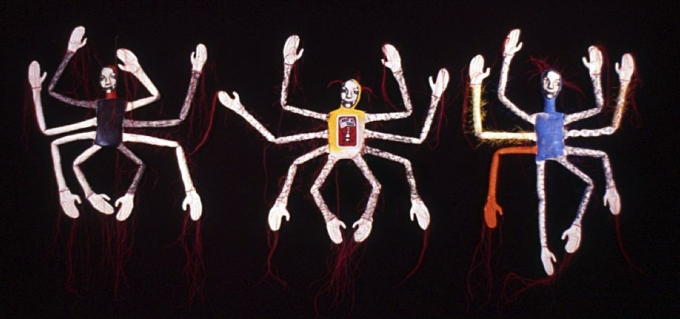
That turned into a series that ended up being titled Will the Real Slim Shady Please Stand Up? The basic theme was identity and whether you wanted to present yourself in the most genuine way possible or whether you were going to posture to try to fit into the status quo. It was all of these various characters where some of them were obviously doing their damndest to fit into what society expected of them and then other characters that didn’t give a damn and were just kind of flying their freak flag.
So, that led into this sculptural body of work which is very much connected to the idea of the freak show and embracing difference.
PG: Since we’re talking about the notion of the dolls, could give me a few of your thoughts on people calling them dolls? How do you like that? Does that bring different connotations that you don’t want there? That you play off of?
JM: Well, in the beginning I was really sensitive to the fact that people were calling them dolls. I didn’t like it. I was afraid that people would not take the work seriously. I was concerned that they would be seen as craft and not art, particularly because I was using traditional doll-making materials, which was fabric and stuffing, and, you know, crafty stuff basically.
So, once I got over myself with that [laughs, joined by audience]…and it WAS just ME getting over it.
PG: Just you getting to the point where, “I don’t care what people think…”
JM: Yeah, or “This is OK”. Because of the fact that I’m using these materials of course that’s going to be the first association that people have with them. What I learned was that, that wasn’t a bad thing.
This association that people brought, this connection that they had with the dolls…dolls are something that are found in many cultures and we all have a history of some sort with dolls. The fact that that is a point of connection – that people immediately feel comfortable approaching the work and engaging with the work because of that – is very powerful. That’s what I learned about it. So, people still call them dolls, or puppets, and the thing that has changed is my attitude about that. You know, that’s great.
PG: Cool. Yeah, however you need to connect with the work.
JM: Yeah, exactly, and knowing that they’re not meaning it in a bad way. They’re not putting down the work…that’s just how they’re connecting.
Audience: What do you call them?
JM: I actually refer to them as figures. I’ve always referred to them as figures, but then so many people call them dolls. And then they started getting written up in newspapers as dolls, and then I’m “OK, fine, they’re dolls” [general laughter]
PG: Ride with it.
JM: Ride with it, ride with it! Why not?
PG: So I think everybody saw the framed sketches that are on the wall when you come in. Those are preliminary drawings for the work, but the question I had was how much of that is really planned out before and how much happens through the process of making?
JM: Right. So, this body of work is very different in the sense that I don’t normally do sketches for my work. I do have a part of my practice which is 2-D works on paper but that is usually completely separate. They don’t cross over, they don’t connect with my three dimensional work.
For this body of work…one thing I should mention, actually, and give a shout out to, is Queens Council on the Arts. I got an Individual Artist grant to complete these works and one of the requirements was that you need to show the work in the year that you got the grant. [laughter, joined by audience]
Knowing how labor-intensive the work is I knew that I really had to use my time wisely so I did a lot of the pre-planning down on paper, which I would normally never, ever do.
Normally I just like to jump into the sculptural material. I build the figures and I have my little seed idea and then from that I’m adding stuff. I’m making little outfits, I’m making wigs, I’m making shoes. I’m deciding they need to be internally armatured so I’m ripping them apart, and I’m putting the armature in, and then I’ve decided that’s wrong so I’m ripping it out again. There’s a real creation and destruction that happens, generally. But you know, as I say, this time I needed to have a bit more of an idea just to make the most of time.
PG: Your practice is super detail oriented, even down to your drawings – your preliminary sketches – are done on archival paper.
JM: Yes! [laughter, joined by audience] You never know [more laughter]. The one thing I’ve learned over time is, never do anything on crappy paper [general laughter]. Don’t, don’t. ‘Cuz you don’t know. It might become one of those things…
PG: We should talk a little bit about the process of us working together. It’s been a very involved process. We’ve met several times throughout the course of the last couple years. Jody and I first did a studio visit about a year and a half, two years ago?
I think we both were, like, “We would really love to work together on a solo show”. When this opportunity came up it was kind of the perfect opportunity to work together. Do you want to say anything?
JM: Yeah, I do! We met in mid 2018 and at that time I had many of these characters that you see in the dioramas finished, but of course they had no environments. The figures that you see standing here were being held upright with doll stands, which is how – if you go back and look on my website and look through the Slim Shady series – you’ll see that the ones that are standing are on doll stands.
There were two really important questions that Peter gave to me on that day just in our conversation. One was, “What’s up with the doll stands? Why are the stands there?”. [general laughter] And you know, I really, honestly, was a bit embarrassed because I couldn’t think of anything better to say than, “Um, that’s what makes them be upright?”. [general laughter]
That really got me thinking in terms of, “OK, how can I make them more activated without having that slightly distracting armature – external armature – with them”. That was the first thing that got the wheels spinning.
And the second thing was, “Do these characters have stories?”. And, of course they did, but, they’re all in my head. Because you can only fit so many details on the figure itself – and they are all incredibly detailed – in order for those stories to be able to be read by somebody else, there needed to be more. There needed to be more and that’s where the idea of the dioramas and the environments that these figures could be placed in came from.
PG: You’ve really gone down the rabbit hole on it, too.
JM: I did. Did you expect that? [general laughter]
PG: I think from knowing your work there’s always an incredible amount of detail and thought put into everything so I knew and I could see that that was there. I did not think that you would be taking it to this level. I mean, you’ve really done something amazing here.
I was hoping you could talk a little bit, too, about the art historical references in the work because a lot of the works, you’ll notice, are referencing pieces in art history or contemporary culture.
JM: Yeah, for sure. So I’ll talk about the art history references first. It makes it fun for me to have hidden easter egg things in pieces and I feel like this will be fun for whoever recognizes this. I think about that as I’m making work because I love it when I’m looking at a piece and I’m, like, “Ahh! This artist is totally referencing so-and-so!” [general laughter]
So for Lionfaced Man you may recognize the painting – or is it a mirror? – behind the bar as being the Manet painting Bar at the Folies Bergeres. What I’ve done, of course, is I’ve removed the front of the female figure and just placed him in front instead. The funny thing is, is that if you look at a picture of her face and you look at a picture of his face, their expressions are the same. [general laughter] This sort of non-plussed “Oh, dear God…”.
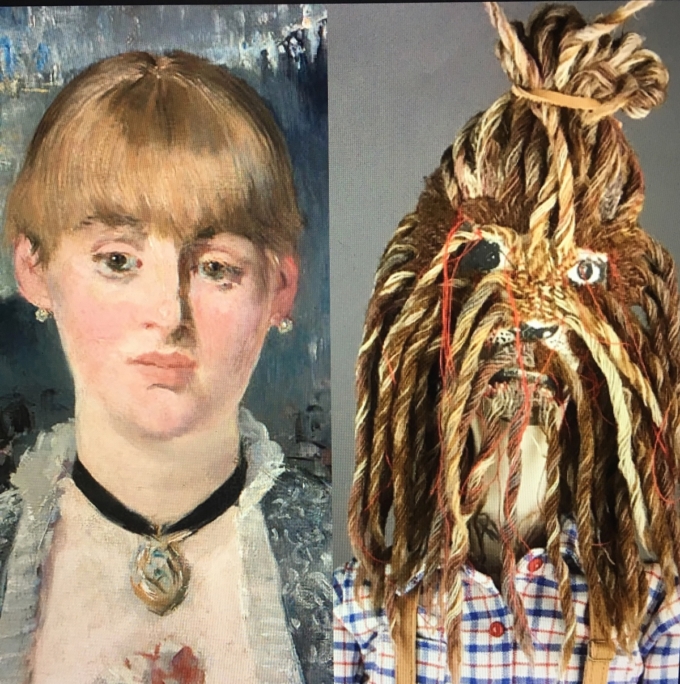
Manet is one of my favorite artists. I just love how he played with composition and that was always one of my favorite paintings. It just fit this piece really well and this idea that I had for this Lionfaced Man. I knew early on that he was actually going to be one of the characters that wanted to posture and fit into society and not stand out.
So of course he’s like a Brooklyn hipster working in a kombucha bar and he’s got the man-bun up top [general laughter] and everything. You know, the braces, and the skinny jeans. That piece just kind of fit perfectly. Of course the bar itself, the Folies Bergeres, was a place where they would have circus performers and it was a real sort of spectacle kind of place where you could go, so it melded quite nicely with his [the Lionfaced Man’s] background of being in the sideshow.
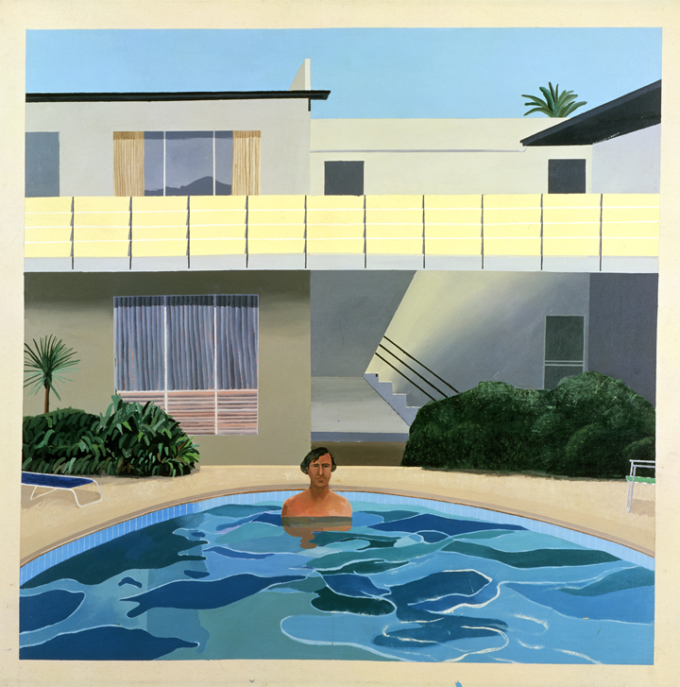
Another art historical reference, the piece a little further down the wall, the Dogfaced Boy. The painting for that backdrop is David Hockney’s Portrait of Nick Wilder that has been – a section has been – taken, basically, and mirrored on itself. Of course Nick Wilder has been taken out of the picture and we’ve just got this sexy beast left there. [general laughter] Then, of course, also doing more mirroring by building the fence out that mimics the fence that’s along the top of the balcony there.

Again, David Hockney is kind of one of my heroes. I love him. I also feel like there are parts of his life where he was an outsider: living in Britain, being a gay man when it was still technically illegal to be a gay man in Britain. It felt like a good match for that piece.
For the Hermaphroditic Goat, some of you may recognize the posture that the goat is standing in – she’s mimicking the sculpture Degas’ Little Dancer. Her ballet slippers are on the bottom of the plinth there. And, let’s see…
PG: The Monkey Grrl as well…
JM: Oh, yes – the Monkey Grrl! Yes, the Monkey Grrl is my little homage to the Guerilla Girls, of course. The poster in the back of that was inspired by the Warhol/Basquiat – 1984 I think the show was? – the promo for that show was they (Warhol and Basquiat) were having a fight. They were in the ring together and they were boxing together. Of course they’ve been removed and she’s center stage in the ring, ready to kick some butt.
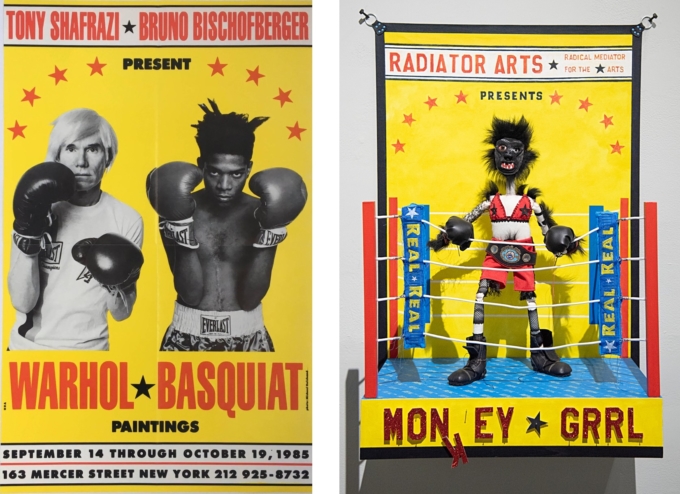
PG: So, I want to pivot a little bit here, because obviously sideshow and the circus is a huge part of this work. I mean, I think the bizarre and the absurd has always been a part of your work but in this body of work it’s specifically focused on that. So do you want to talk about what your initial interests were? I know it’s something you’ve been working on since 2011. Maybe talk about the book that inspired a lot of these pieces?
JM: I will just collect things that interest me and I may or may not use them and I had started collecting books on the circus and sideshow, and PT Barnam, and reading all of that kind of stuff as early as 2011.
The faces on some of the figures here were created – I had photoshopped a document that was created – even earlier than that because I was thinking of doing an articulated paper based series that was based on the circus, so, I already had that in my mind. That has not come into fruition – at least not yet. The faces started to get used. I had The Bearded Lady face, I had The Clown face, I had Dogfaced Boy – his face – as well. Those were created well before this [gestures to room] ever came to being.
I’m so interested in the power of difference and not fitting into the status quo. And this fascination with “real” versus “fake” and part of the sideshow, a lot of that was about “the con”. What would be advertised on the posters outside, you would think, “Oh, I’m going to see this thing”, and then you get inside and it would be slightly different. That has always fascinated me. I really felt like, with concentrating on this type of theme…
PG: The idea of “realness”…
JM: Yeah, the idea of being real. You’ll notice that the whole theme of “real” is in several pieces, crosses several pieces…
PG: And on the buttons…
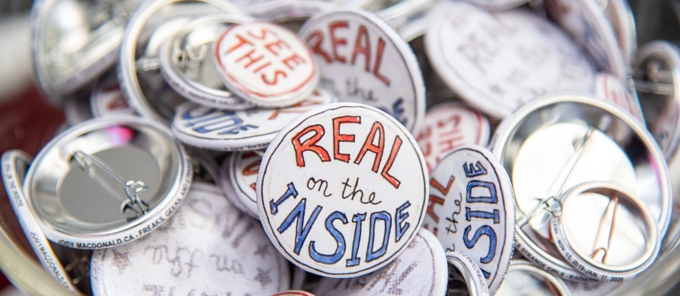
JM: And on the buttons, right. The “Real on the Inside”. Basically that promise that if you pay your money to get on the inside of the tent, it’s real on the inside.
I also love that idea of being “real on the inside” – you can read it so many ways. Especially with these being dolls, too. I love the reference to Pinocchio, who wanted to be a Real Boy. It’s like, “I’m real on the inside – really, I am!” It just fit and there’s a lot of meat there for me to sink my teeth into and really be able to go down the rabbit hole.
PG: So, within that, the book that you ended up arriving at was Freaks, Geeks, and Strange Girls…
JM: And that was published in the nineties…
PG: I think ninety-six…
JM: Ninety-six, and it was a collection of vintage sideshow banners. It’s a beautiful book. I wish I would have remembered to bring it tonight – it would have been good to have a show and tell. Going through and looking at the banners and seeing what type of acts were being produced and shown really did set the stage for the characters that I was interested in exploring and developing narratives for.
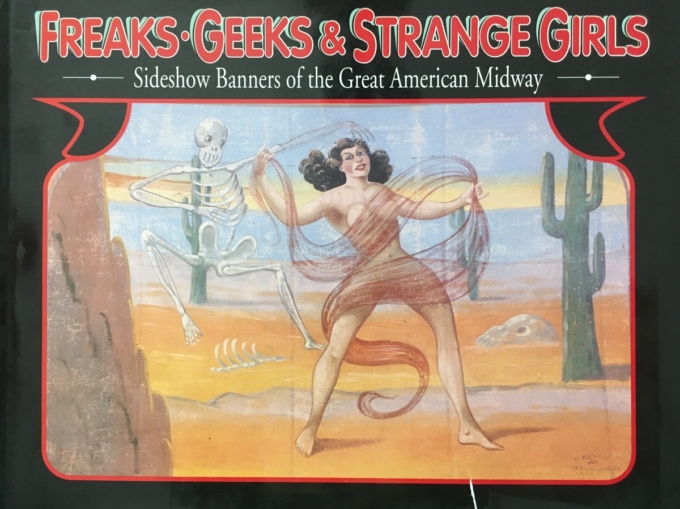
PG: So, I know some of the characters are directly based on those specific advertisements. Are any of them just totally made up as well?
JM: Kind of…I don’t think I ever saw one for the Hermaphroditic Goat [general laughter]. I’ve seen ones for two-headed goats – you know they would have their freak animal exhibit as well. Some of you may know some of the stories behind that already because Steven Speliotis, who’s here tonight, helped me produce a couple of very short episodes on some of the pieces where I divulge just a few details.
The goat was inspired by an actual Hermaphroditic Goat that lives on a farm in Ontario, Canada. I know about that goat because I have a friend who just knows that I like weird stuff like that [general laughter] and he had a picture of her [rather, I should have said, “them”]. He sent me this photo – this was well before I was even thinking about doing this series – of this sweet, sweet little hermaphroditic goat that was perched on top of a stump with this weird crossed underbite thing. The expression is quite close, actually [laughter] on the goat. I thought, “Oh, this is happening at some point. This is getting used for something.”
Because the hermaphrodite was a staple for the sideshow, and the freak animal was also kind of a staple I just kind of melded those two together based on the fact that I had this image of this actual hermaphroditic goat. That was the seed for that piece coming into being. She is sort of the most made up.
We’ve all heard of Jo-Jo the Dogfaced Boy, the conjoined twins…the tattooed lady was always a big staple in sideshows. Those ones, of course are based on real acts. In fact, The Tattooed Lady, a lot of her tattoos are ones that I tried to replicate in a genuine way from old photographs from one of the original tattooed ladies, La Belle Angora. She was circa 1917. She has a couple of old rack cards where there were illustrations of her, but also there were a few photographs of her. She’s seated and she’s wearing a little bustier costume so you can’t see everything, of course.
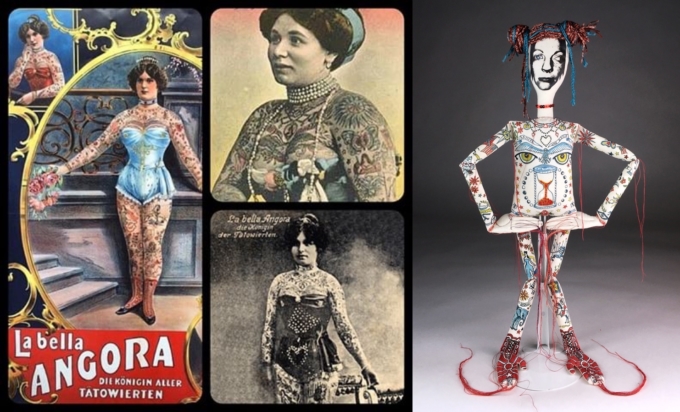
I knew mine was going to be completely naked so I had to make some of [the tattoos] up, but I tried to replicate some of those ones just by looking and going, “That looks like this”, and doing [things] that way. Of course the back is all new tattoos.
It’s all very political. She was made right at the end of 2016 [laughter] and if you read the tattoos you’ll understand all of it [general laughter]. I feel like she’s definitely got a strong political voice. The Latin that is on her body – there’s one that’s harder to read because it’s down where she’s got her hands across her groin area – is basically Latin that says “My body, my choice.”
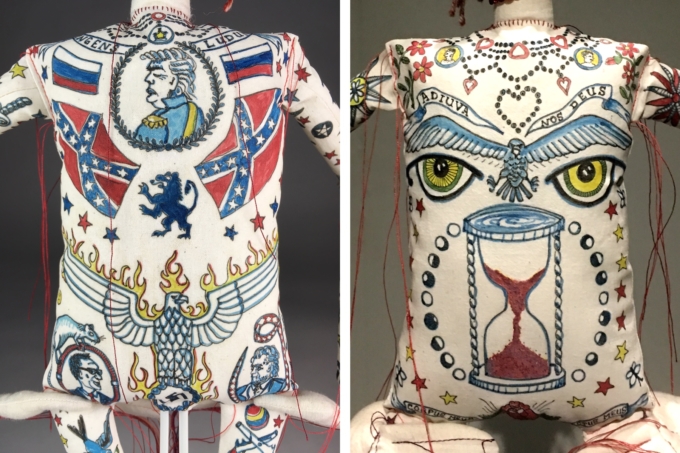
There’s a lot of the “Me Too” movement going on, there was a lot of backlash from the pussy grabbing going on. There’s the two Steve’s on the butt cheeks [laughter] and their animals – their familiars – one’s a rat and one’s a snake. There’s a lot of good commentary of the times that was going on.
Audience: What’s the Latin that was up here [gestures to chest]. What does that mean?
JM: I think on the front it says, “God help us”, and I think on the back is “Huge idiot”. [general laughter]
Audience: Who did you use for inspiration? [general laughter]
JM: I don’t know…I really don’t know. [laughter] The hairstyle as well for her is really dear to me, as right around that time, too, when I was trying to figure out what I was going to do with her hair, Carrie Fisher had just passed. I felt like she needed to have the Princess Leia hairstyle. That’s how little small elements and details happen in a work. The work takes a long time to make so actually it can change a lot as I get influenced just by little things throughout the day.
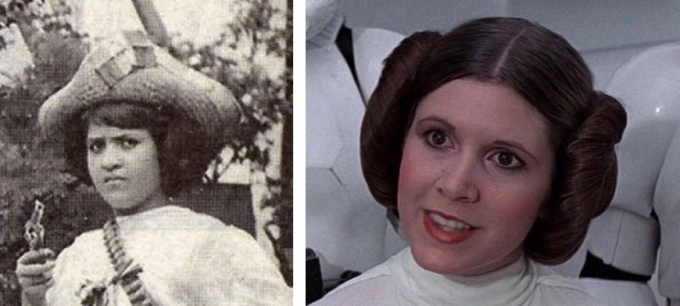
PG: There’s a couple of other – what I think are really important – parts of the work that I’d like to touch on before we open up to questions. One of the main ones being that all the faces on all these figures are yours. So…[general laughter] in essence they’re all to some degree self-portraiture.
JM: I actually don’t think of them as self portraits and I never have. I can’t even tell you how many…I’ve probably made about a hundred figures at this point. The Slim Shady series is huge, it has about seventy figures in it. I feel like I’m using myself more in the manner that Cindy Sherman uses herself in her work. I’m casting myself in these roles. I see these, even though they’re static, as being very performative and I’m casting myself in these roles…
PG: Has this become your new form of performance?
JM: Yeah, it has – it totally has! That’s what’s happened. It really has, all the bits make sense now, you know. Looking back on my practice it all is, like, “OK, this is why. This is why everything.”
And…a history of doing a lot of role-play when I was a child. That was my favorite thing to do, was to be something else. I would get incredibly detailed with it [general laughter]. And I would never do it for anybody else, it would be for me. I would be downstairs in the basement – and I loved bugs, I LOVED bugs so much [general laughter]. I loved praying mantises, that was my favorite [laugher].
I remember having this one-piece Dr. Denton, two-tone green onesie. I was probably five. Being in the basement I WAS the praying mantis. I remember grabbing the pillow like this [mimics bent forelegs of mantis and biting pillow] and biting it, biting it. And because I’d studied them so carefully, having all the weird little swaying movements [general laughter], and the head tilt…
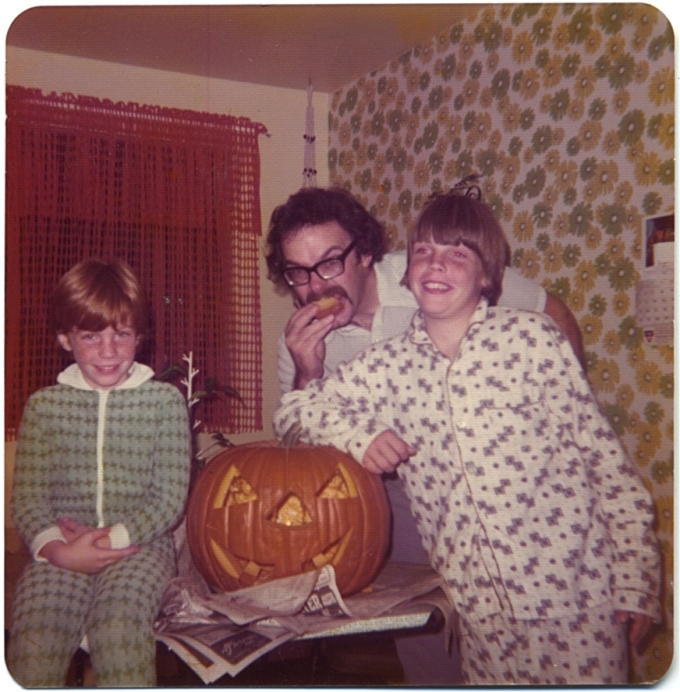
PG: So when you were getting ready to do these [gesturing to work in gallery] is there a similar process? [general laughter]
JM: [laughing] No, no, no! I don’t actually do that now, but you know a lot of people say if you just look back to what you were doing when you were five, that’s what you should be doing. And I’m kind of doing it in this way that I can perform many things at one time.
PG: There’s definitely thousands of more things we could talk about with the work because there’s so many layers of it built in there, which I really appreciate seeing an artist do because the more time you spend with it the more the work is going to give back to you. One of my last questions, and then we’ll open it up to the audience, is, can you talk a little bit about the feet on your characters?
[agreement murmur from audience]
JM: Ahhh, yes – good one! OK, so, the very first one that I was talking about that I made as a test for the spider baby – they just had all hands everywhere, right? It was like an eight-armed baby with hands [laughter]. Perfectly normal. So when I started doing figures that were more like bi-peds I just kept the feet [meaning hands]. Part of that, in my head, I was thinking, “Oh, yeah, opposable thumbs on feet”. Thinking really simian or more ape-like. They just stayed.
I also have figures – some of my older work – some of them are deer figures and their antlers are hands. I kind of used the hands where I could. There’s also Great White Expectations, which is a shark, the fins are hands. Everything is hands. It’s just one of those things that I started doing…
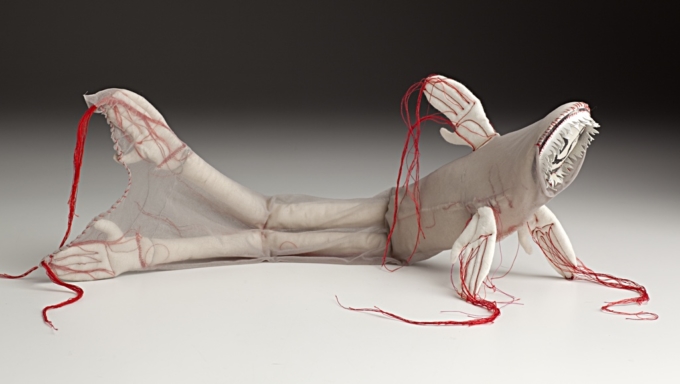
PG: It’s a running thing in your practice.
JM: Yes, it’s a running thing…
PG: Interesting. It’s become part of your language as an artist.
JM: It’s become totally part of the language of this work.
PG: Well, at this point I think we should open it up to you guys if you have any questions about the work?
[raising of hands]
JM: [laughter, to one audience member in the front row] You’ve been waiting!
Audience: The red strings…
JM: The red strings, OK. So the red threads. When I was first doing the tests and I was making all the little hands – I make all the little components separately – I stitched the first one just to demarcate the digits and I used natural colored thread that was the same color as the muslin and you couldn’t see anything. I tried one with black, and I didn’t like how that looked. I tried one with red and I was like, “OK, so…my stitching is all going to be with red”, because it just really felt right.

The first couple of figures that I made I constructed them all without making any clips, without trimming any threads so they all had the long threads on it. I knew immediately that I was not going to trim them. I was, like, “No, I like how this is”. It gives them this rawness. I knew the work was probably going to end up being a little dark anyways and I also knew that that would kind of help to offset some of the cute, doll-like qualities. If I cut all the threads, then they’re dolls. If I leave it as they are, and that’s part of their language, then – to me – that’s what helps to keep them on the fine art side.
People have different connotations as to what they are. A lot of people think of blood…viens…
PG: They’re almost like roots…
JM: Roots, yeah.
Audience: I heard you had a couple of painters that you were influenced, but were there any sculptors that you looked at?
JM: Mmm…well, OK, this is more of a bit of a dig, of course, but in The Clown piece all of those balloon animals are Jeff Koons’ [general laughter]. Well, except for the penises, ‘cuz as far as I know he hasn’t done penises yet [general laughter]. That is shocking, that he hasn’t, right? [more laughter].
Audience: He already is one.
[audience exclaimations]
Audience: I didn’t say that.
JM: No, you didn’t [laughter]…definitely there are lots of sculptors. I mean, one of my favorite artists, in general, is Louise Bourgeois. I love how she uses a lot of her own clothing in a lot of her pieces and I actually do the same. The denim…I upcycle everything, I keep everything, I am a [pause] organized hoarder.
The jeans in Lionfaced Man, that was an old pair of jeans of mine that finally blew out and I just had to keep them because I knew I’d use some of the denim for something. The shirt in the Lionfaced Man is actually one of my husband’s old shirts. And so on and so on. That’s how it happens. There’s all of these items and fabrics that have had a former life that pop up.
PG: I have another questions for you, too…what’s something that has really surprised you about where the work has gone and where it’s taking you? What you didn’t expect?
JM: [pregnant pause] Well, what’s surprising for me, and I didn’t kind of get a chance to push it this far because I ran out of time. I kind of feel like these characters have a dialogue with each other and I kind of really wanted to see parts of them popping up in each other’s spaces.
I have ideas. I’m, like, “Is it wrong for me to change the work now that’s it’s been exhibited?” [laughter]. They’re isolated, still, on their own here and I would almost like it to be evident that they know each other and that they hang out with each other. You know what I mean?
Audience: How would you…what would you add?
JM: Well, for example, for the Twins I would like to add, I think, just a little photograph, like a headshot, of Lionfaced Man and have him tucked up in the mirror [laughter]. That would further inform this storyline, which is based on…do people remember the song “Sisters” from White Christmas? So, you know, there’s one dress, and that whole thing about, “she wears the dress and I’ll stay home”. How is that possible, to do that [as conjoined twins]. Also the idea that “God help the sister who comes between me and my man”. I kind of almost want there to be little back-stories.
For the Lionfaced Man, I would love it if he would have a pair of boxing gloves hung up behind the bar. You know, being a boxer doesn’t pay the bills so he’s moonlighting at this kombucha bar to make more money. Just to see how they could be tied together in a way.
Audience: What are the frames around…especially these two, and then into the wall [gesturing to Dogfaced Boy’s backdrop and nails]. Is there a particular statement behind that?

JM: Oh, well the backdrops are referencing the vintage banners. The rings and the leather straps that they’re attached to are very much taken from those banners, the way they were constructed. The nails are actually – the vintage flooring nails – those are, for me, they really brought to mind tent spikes. Circus tent spikes like when you put the Big Top up. That’s why I chose those specifically.
I don’t know, did I answer your question? Did I miss anything?
Audience: Yup, yup, yup.
Tamas Veszi: You know how you were saying when you were re-enacting as a child…
JM: Yes
TM: But also, when I was mentioning to you, “What about animation?”, you were kind of surprised. You were, like, ‘Yeah, but…” You were kind of hesitant about it.
JM: Only for this show because…
TM: No, no, I understand, but that’s what I’m saying, because you say, put them together…
JM: Oh, yes, for sure…
TM: ..so they’re activating.
JM: I mean, it’s kind of heading that way. You may have remembered the clown pull-toy pieces that I was working on – that I had to put aside so I could finish this. The work is heading in that direction in that I started playing with some animation as well. Just another labor-intensive medium [general laughter]
TV: Just hire somebody.
JM: I’ll just hire somebody, yeah, sure!
PG: Even the crates that Jody built to bring this work over here are down to the detail [general laughter]
JM: When somebody else gets to install the show and they’re opening up the crate, I kind of want it to be exciting for them. I want them to be delighted when they open it up and go, “Wow! Lookit! Everything has a spot, and here’s the directions of how to put it together!” It’s like a toy to put together, in a sense, right?
Audience: I don’t think that there’s a vocabulary to describe your work. You started saying sculpture, it’s not a sculpture. Then you also used the term “dolls”. I didn’t think of this as a sculpture in fact I’ve never seen anything like this. It’s not even a diorama, really.
JM: [laughter] Yeah, that got stretched.
Audience: And I never thought that these were dolls. They were just creations. So, in a way, maybe if you use the terms sculpture or other terms it’s doing your work an injustice.
JM: Oh, I need to come up with a new term…
Audience: Yes.
JM: OK. Alright, if anyone has any ideas, let me know [general laughter]. Thank you!
Audience: I don’t have ideas but I have a question. So with this one [indicates Hermaphroditic Goat] I was just getting a chance to read part of your thoughts about when you were working on these, what became mirrors. And I just wondered how you sort of sorted through that and decided not to use…
JM: …the small reproductions of the artwork…
Audience: Yes, right. Exactly.
JM: Part of that was I wanted this new beauty ideal, right? So, the Greek column, the Greeks being the fount of beauty ideals, and this shifted, tilted perspective that’s happening, right? I wanted to be what was reflected to be that different beauty ideal. Also what I wanted was for people to catch themselves looking in at the piece and also catch themselves contained in that environment.
Lots of pieces do have a reflective surface where you can catch yourself, distorted albeit, like a funhouse mirror. That distorted reality.
Audience: Maybe I misread it, but I thought you also had the idea of some of them, at some point facing outward. Is that right or no?
JM: No, no. But this is much more open. The piece was originally going to be completely boxed in and areas cut out that you would just look in. It evolved into being more of this [indicated piece].
Audience: And why are some of the mirrors hanging by one thread?
JM: [whispering] The establishments falling apart. [general laughter]
Audience: Now I know you had a deep intention!
JM: I had people coming up to me at the opening – also with Monkey Grrl with the “K” that’s slid down – my dear friend who was here, there were people going, “Oh my God, it’s falling apart!!”. So she went and put it back up [general laughter]. There’s actually a photograph of it opening night with it up. I was, like, ‘That’s wrong!” [general laughter]. My friend came to me and she said, “You know, I just want to double check with you – we thought maybe the “K” had fallen down.” I’m like, “No! It’s supposed to be like that!”
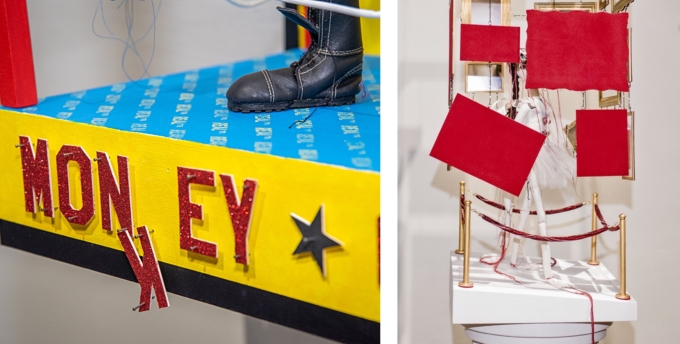
You know, it’s that whole…
PG: The DIY…
JM: …the DIY, but also that what’s on the surface is slightly crumbling. That also is happening in the Dogfaced Boy where the terrazzo tiles are starting to curl up, there’s grass growing in between the tiles.
Audience: Could you talk a little bit more about your relationship and the influence that Peter had on your work?
JM: Oh, yeah, sure! Quite a bit. Like I said, those two questions that he asked me, which really are very simple and could almost be inconsequential really.
PG: I only remember asking one of them [laughter].
JM: You know, I actually made notes after you left, because I forget it so I actually typed out notes after so I remembered all of it.
The stands alone – when I did the first piece and I had figured out how to do this internal structure to make it stand on it’s own, and then I actually put it in place and it stood – I was so incredibly excited!
I didn’t think it was going to change the work that much. It just gave this little bit of uncanny magic. You’re looking at a doll, and you’re like, “It’s made out of fabric and I know that it’s stuffed and that it shouldn’t be standing and yet it’s kind of standing on it’s own, not holding on to anything and it’s got it’s arm up in the air.” It just made it More.
Audience: Like Pinocchio becoming a real boy.
JM: Yeah, yeah!
PG: Just to finish Steven’s question, I think mostly our interaction together was every two or three months we would do a studio visit. It was basically just asking questions.
JM: It was. It was like, “What’s happening with this piece?” Or I’d say to Peter, “I’m thinking of doing this…”, and he’d be, like, “Oh no, don’t do that,”[general laughter]. And then I would turn around and do it anyways [general laughter].
[To Peter] I’m sorry – I did that with a couple of pieces. But Dogfaced Boy’s pool, that never would have happened if I didn’t not listen to you [general laughter].
Just that interaction and Peter has a great eye. For the piece that’s in the little ante-room – The Tattooed Lady – she’s all on her own. She has so much going on just with her that Peter advised that I should keep the diorama very simple – if you can call it a diorama. My whole definition of diorama kind of slid as the work happened until I ended up with the goat and The Tattooed Lady. I think of this one [indicating the Lionfaced Man] as being more of a traditional diorama where there’s elements set into a rectangular area. The fact that I’m breaking out of that is really exciting.
But, Peter’s idea was she should be just on her own on a white plinth. Of course I needed something a bit more than that to inform the piece a little bit more…
PG: Especially after doing this one [indicating The Hermaphroditic Goat]
JM: Especially after doing that one! Yeah, I know. I knew that I wanted to do this presidential run podium type thing but with a dripping flag motif – the stars and the stripes kind of dripping down, melting down.
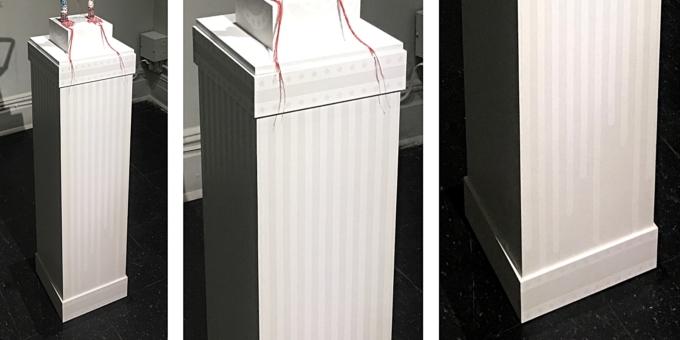
The white on white, that was it. I tried it with color – and I like it with color – but I was, “No, she gets totally lost”. So, white on white for the win.
Audience: You have made dioramas in the past – how were they standing up?
JM: Yeah, I made the one that…
Audience: The big hunting scene…
JM: Yes! That’s the one that’s using the Frida Kahlo painting in the background. They’re on doll stands, and they are visible but you don’t really notice it that much. But they’re still there and I kind of want to go back now and change that piece because it would make it “more” if I just had them standing.
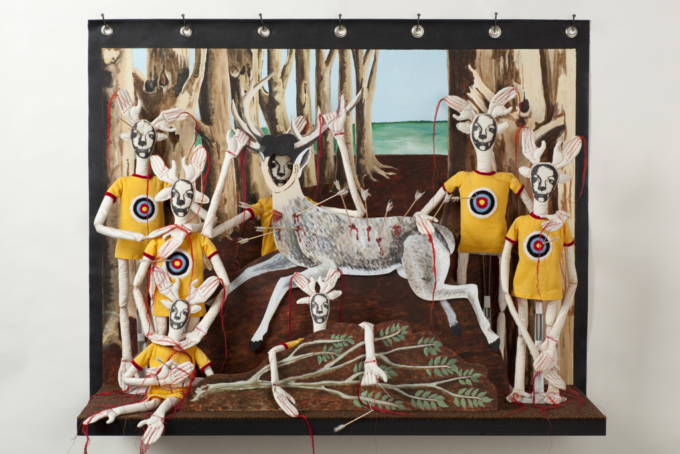
I’ve done other types of diorama pieces that don’t necessarily have a shelf but they have other elements that bring in more of a containment. That piece with the hunting scene was from 2006. I kind of got away from that and went back into doing individual, smaller sized figures. Part of that was I had this move to New York.
I moved from Vancouver to New York in 2014 and my work changed. My studio was half the size and the work shifted a little bit. I went back to just making singular figures instead of larger type things. You know, I didn’t have the same access to tools. Not that I did for these, either. I made these basically using a jig saw, and a drill, and that’s about it [general laughter].
PG: I think we should end the formal talk there but please stay, hang out, look at the work, talk to us, ask us more questions. Thank you again, everybody! [clapping]
JM: I didn’t get to say my “thank yous” and I feel like I should do that right now before we break up. Thank you, Radiator Gallery, for trusting in me to be your first solo show. That was really an honor and I couldn’t imagine a more perfect space for this body of work.
Thank you so much, Peter Gynd, for agreeing to work with me. It’s been a blast.
Thank you to Queens Council on the Arts for seeing value in my project and funding this work.
Thank you to my husband – there he is, in the back – who really is the best art mule, ever [laughter]. Honestly, this work, a lot of it would not be made without him. Thank you so much.
If I’m forgetting anybody, I’m sorry. I’m probably going to remember in about three minutes and then feel really bad for about three days [laughter]. Thank you so much for coming – let’s have a drink!
[clapping]
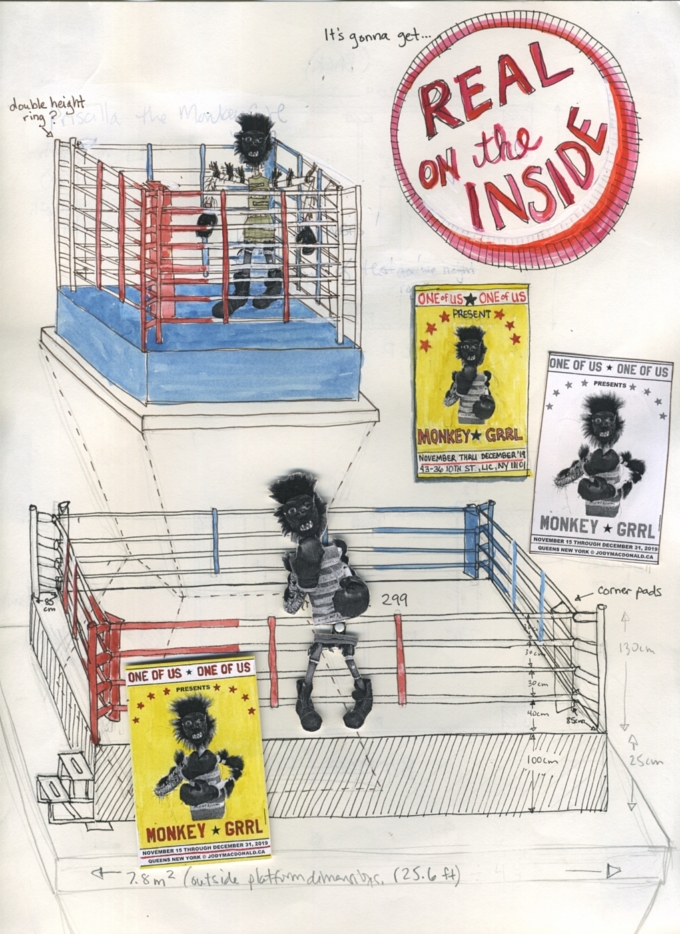
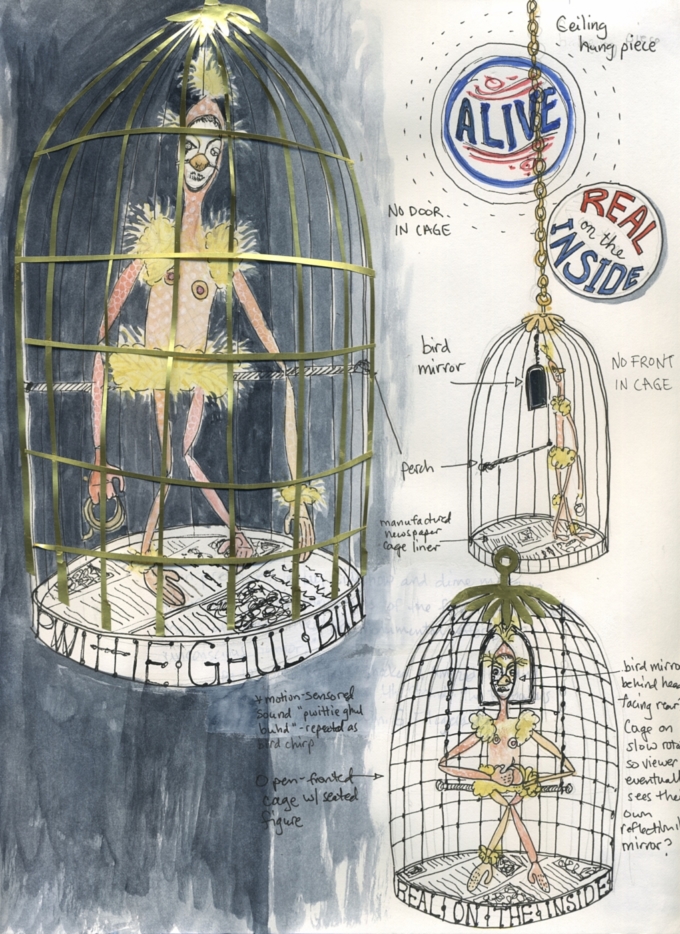
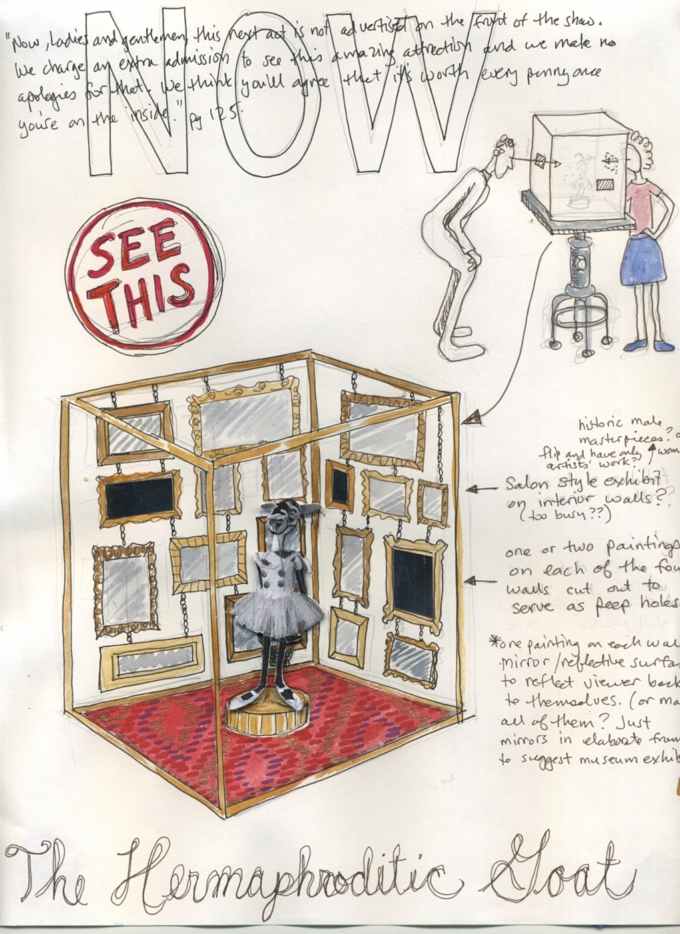

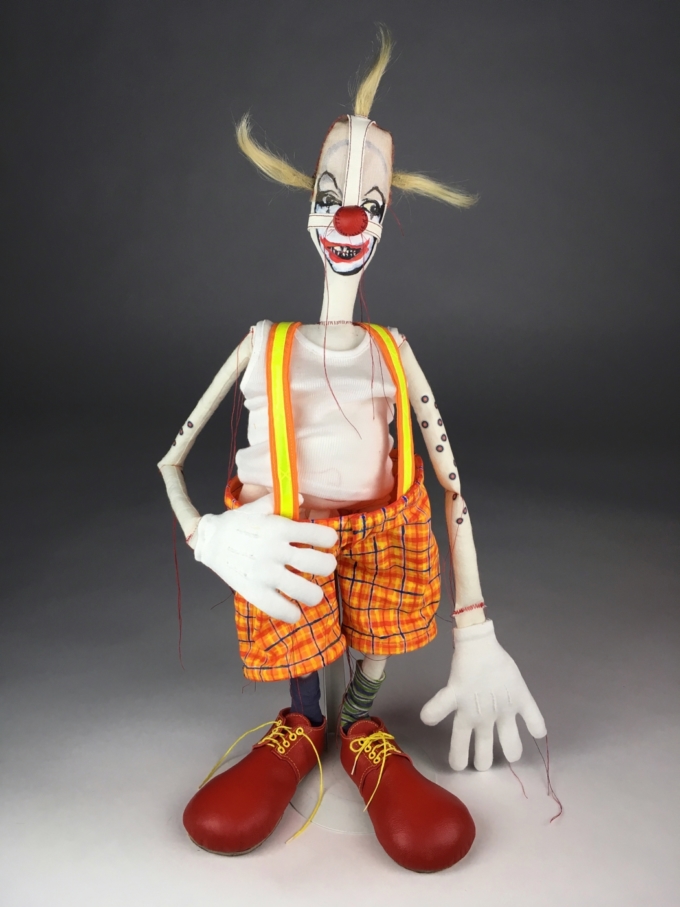
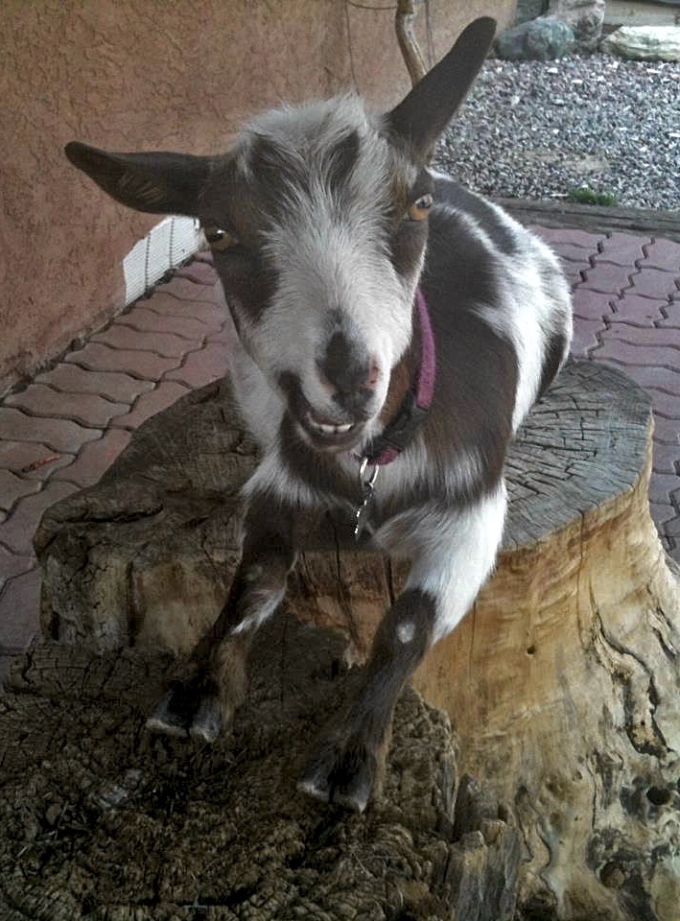
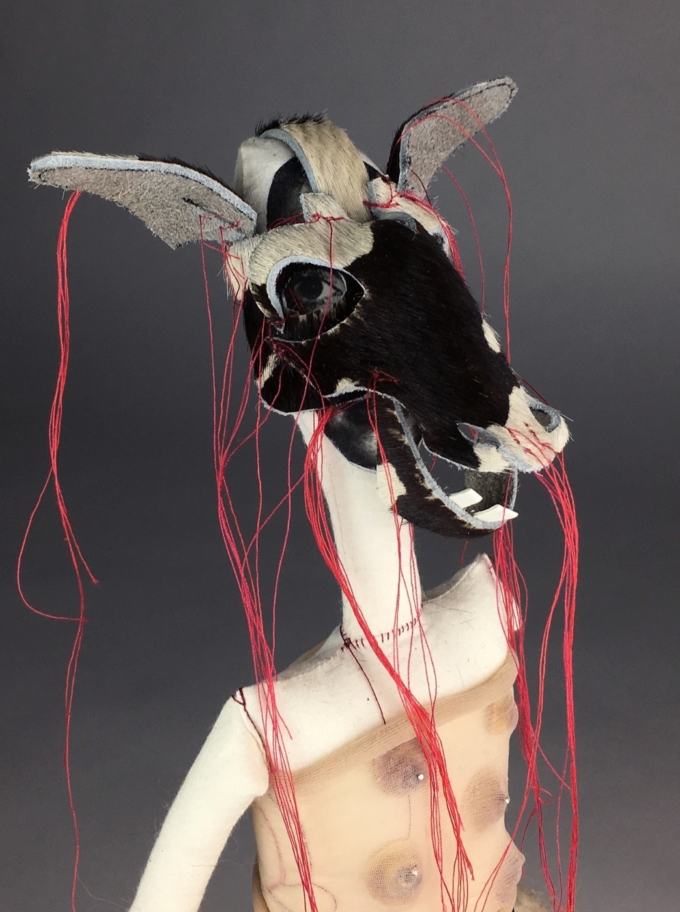
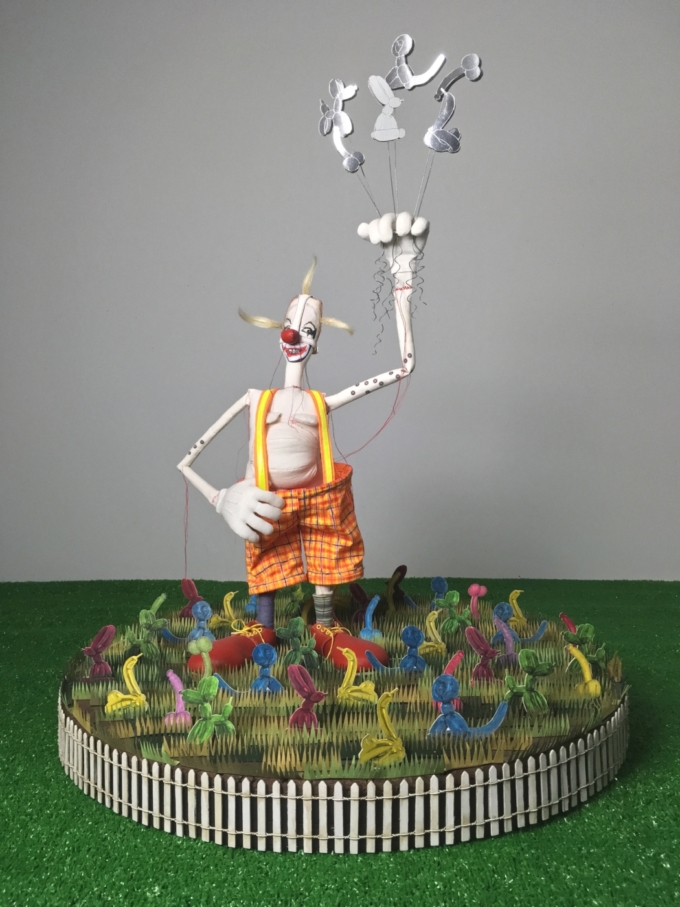

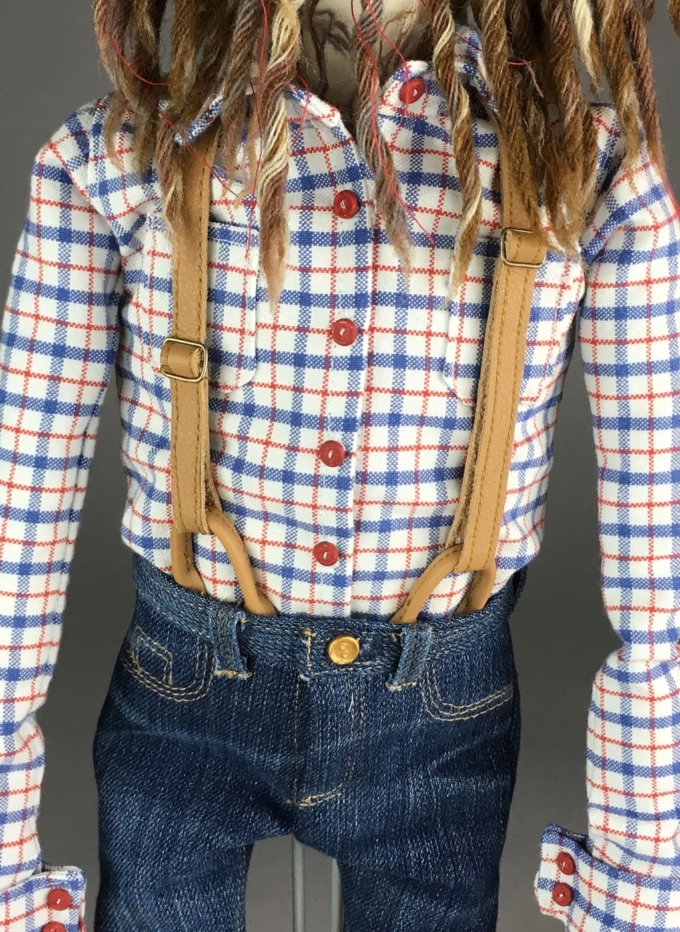
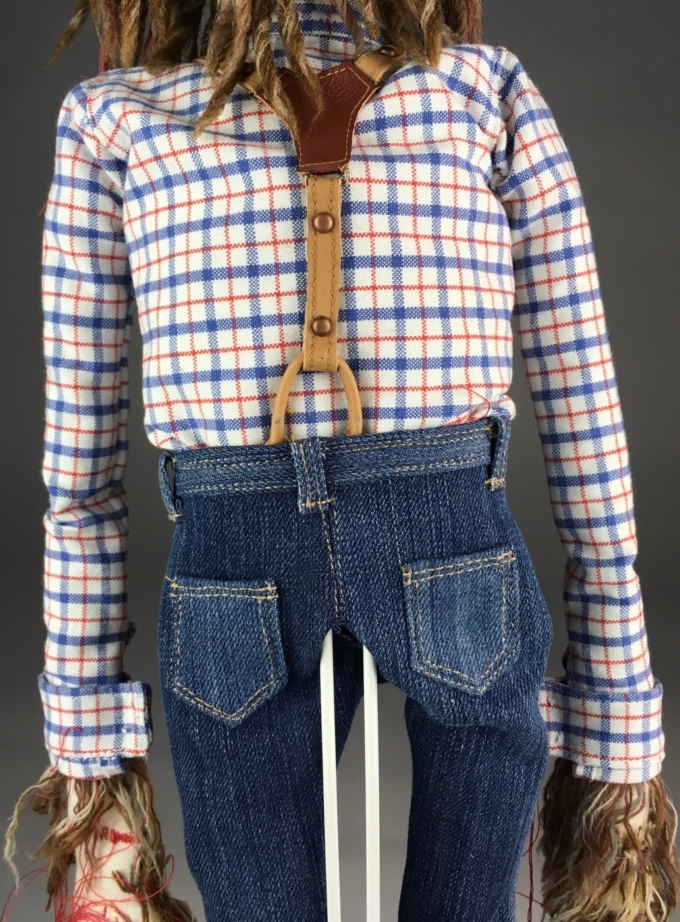
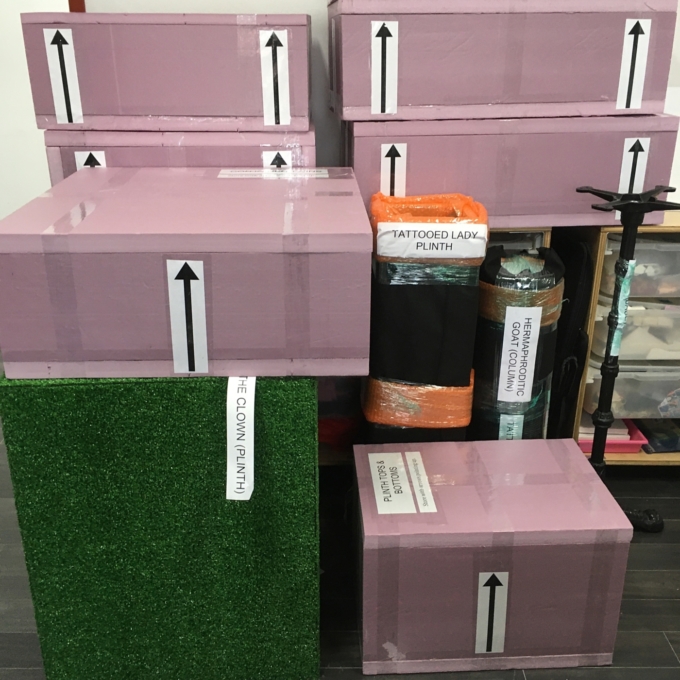
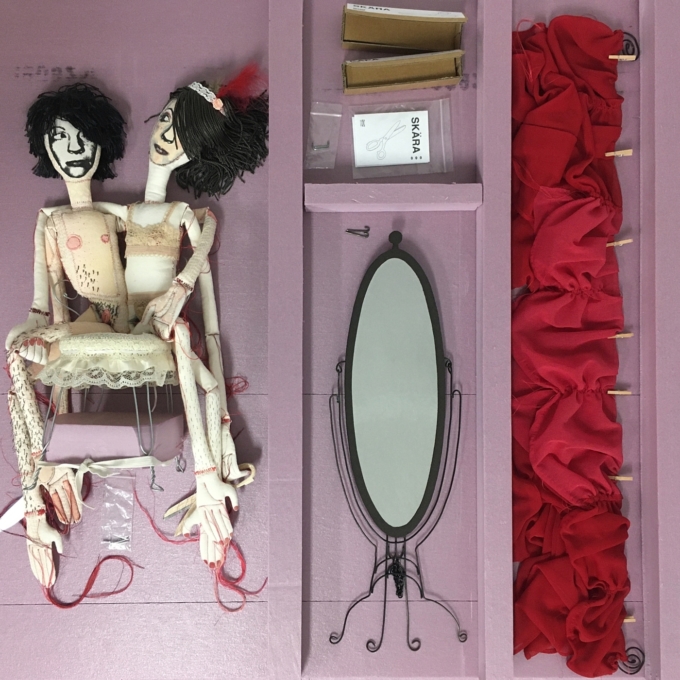
Thanks for this, Jodi. It’s so good to be able to have a sense of the development of the ideas behind each piece and the direction you’re heading in. Just sorry I can’t see the work in person. Congrats! It feels like you’ve really deepened your practice with this exhibition.
Jody! Feel like I’ve just had a wonderful conversation with you! and sent me back in time and place.
Very inspiring and informative!
Thank you for reading, Ruth! Glad to take you on a time machine ride 🙂 There will be more wonderful conversations in the future, I am sure!
Thank you, Ilze. I agree with you, working so intensely on this project (and closely with a curator) truly pushed the boundaries of my practice – I’m so happy you can see that. I hope to mount this series in Vancouver one day and maybe you will get a chance to see it in person then. Thanks so much for your interest and following my work!